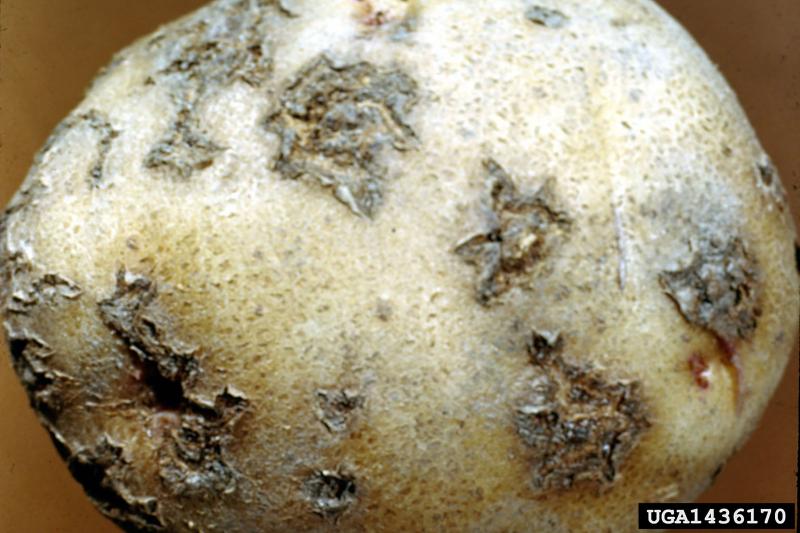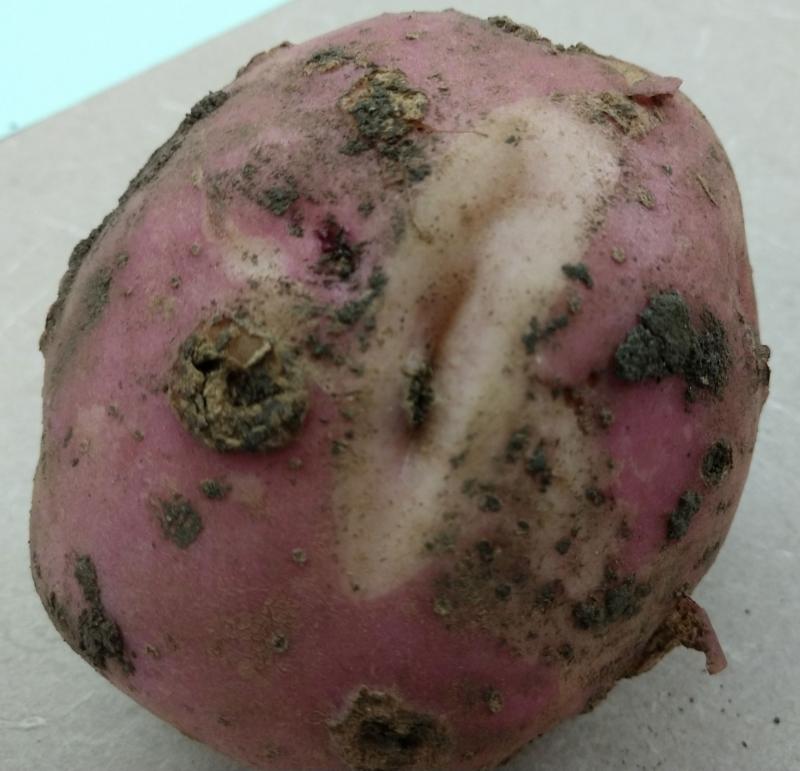Written by Rhoda Burrows, former Professor & SDSU Extension Horticulture Specialist.
We are accustomed to perfect-looking potatoes from the grocery store, but sometimes our homegrown tubers don’t meet that same standard. Following are a couple of common problems home gardeners may contend with. There are several other diseases including blight or ringspot that can cause surface or internal rots; these can be diagnosed by a plant pathologist.
Potato Scab

Potato scab causes corky lesions (which may resemble scabs on people) on the surface, and severe cases may also cause pitted lesions about 1/8 inch deep. While it disfigures the potato and may shorten shelf life, scab is not harmful to humans, and may simply be removed by peeling.
The Scab bacteria prefers warm dry high pH soils, so it is quite common in South Dakota. The infections may be reduced somewhat by maintaining good soil moisture for about a month following the onset of tuber formation (about the time the plants begin flowering) until the tubers are about 1½ inches in size. However, don’t allow the soils to become soggy, as this will encourage other diseases. The application of manure may stimulate the growth of the bacteria, as they also feed on organic matter in the soil. They can survive for many years on organic matter in the soil, and can also infect beets, carrots, radishes and turnips. Planting small grains, buckwheat or alfalfa may help reduce the disease organisms in the soil.
The best defense against scab is to plant varieties that have at least some resistance to the disease. Be aware that no variety has complete resistance, so you may still see some scab. Superior, Freedom, Red Norland, Russet Burbank, Oneida Gold have good resistance; Red Gold has moderate resistance. Yukon Gold is moderately susceptible, and Kennebec is very susceptible.
Knobby or Cracked Potatoes

Periods of drought or high soil temperatures can cause the tuber to stop growing. Sudden influx of water can cause growth cracks (which often heal over before harvest).
Portions of the tuber may not regrow as quickly as other portions, resulting in knobby potatoes. Keeping the soil more evenly moist will help avoid this problem.
Hollow Heart

Excess nitrogen can lead to overly rapid growth, causing the tuber to become hollow in the center, and the surrounding tissue will turn brown.
Sudden influx of water after a drought, or potassium deficiency can also cause this condition.
Wireworms
Wireworms, the larvae of click beetles, feed on potatoes, boring small holes into the tubers. They can also feed on plant roots, reducing the plant vigor.
Crop rotation can help reduce wireworms. Unfortunately, the crop rotation that may reduce potato scab (see above) may increase wireworm larvae; the exception is that buckwheat may reduce levels of both scab and wireworm. For small gardens, carrots or potatoes may be placed as bait, and dug up every few days to destroy the larvae.
Storing Potatoes
Allowing potatoes to stay in the ground for a week or two after the tops die helps the tubers to “set” their skins, so that they will store much longer. The process may be aided by cutting off vines a few days before harvest. After digging them, allow them to further cure by storing them in a dark but well-ventilated area at room temperature for a few days. The tubers will then keep best stored near 40 to 50 degrees F, in relatively high humidity. Potatoes should always be kept in a dark area, or they will turn green and develop toxins. Do not store potatoes near apples, as ethylene given off by the apples may cause the potatoes to sprout.


